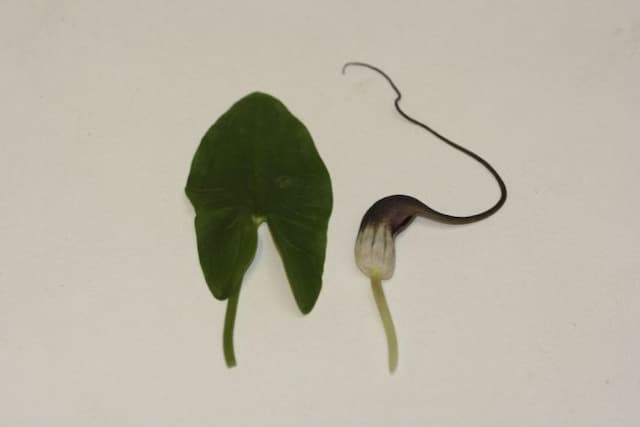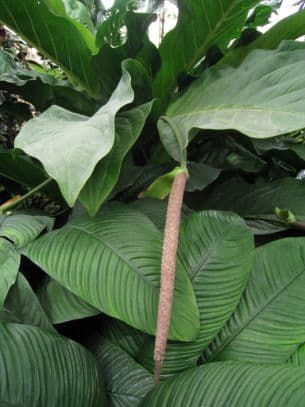Calla Lily 'Airbrush' Zantedeschia 'Airbrush' (PBR)

ABOUT
The Zantedeschia 'Airbrush', more commonly known as the Calla Lily 'Airbrush', presents with a remarkable and eye-catching appearance. The plant bears large, trumpet-shaped flowers with a distinct flair. The blooms are characteristically elegant and boast a blend of colors that resembles the fine strokes of an airbrush. Typically, the flowers feature a gradient of hues, often starting with a creamy base that transitions into pink or purple tones, with speckles and streaks adding texture and depth to the petals. Surrounding the central spadix, which emerges from the flower's core, is the spathe—a flaring, leaf-like bract that wraps around the spadix and is integral to the plant's unique look. The contrast between the spadix and the spathe is striking, lending a sophisticated appeal to each flower. The foliage of Calla Lily 'Airbrush' is also charming, displaying lush, glossy leaves that enhance the overall attractiveness of the plant. The leaves are typically arrow-shaped or lanceolate and can provide a rich green backdrop that makes the vibrant flowers stand out even more. This plant has a clumping habit, with the leaves growing directly from the underground stem, called a rhizome, creating a dense cluster of greenery. Overall, the Calla Lily 'Airbrush' is a plant regarded for its exceptional beauty, appreciated by gardeners and flower enthusiasts alike for its decorative flowers and elegant foliage.
About this plant
 Names
NamesFamily
Araceae
Synonyms
Calla Lily, Arum Lily
Common names
Zantedeschia 'Airbrush' (PBR)
 Toxicity
ToxicityTo humans
The plant commonly known as Calla Lily is considered toxic to humans. The toxicity is due to compounds known as calcium oxalate crystals, which can cause intense burning and irritation of the mouth, lips, and throat. If ingested, symptoms may include nausea, vomiting, and diarrhea. Swelling of the mouth and throat can lead to difficulty in breathing. In severe cases, medical attention is necessary, particularly if a significant amount has been swallowed.
To pets
The Calla Lily is also toxic to pets, including cats and dogs. Similar to its effects on humans, the calcium oxalate crystals in the plant can cause oral pain, drooling, vomiting, difficulty swallowing, and a decrease in appetite. In severe cases, ingesting parts of the plant may lead to swelling of the airways, resulting in difficulty breathing which can be a life-threatening situation requiring immediate veterinary intervention.
 Characteristics
CharacteristicsLife cycle
Perennials
Foliage type
Deciduous
Color of leaves
Green
Flower color
Pink
Height
2 feet (60 cm)
Spread
1 foot (30 cm)
Plant type
Herb
Hardiness zones
9
Native area
South Africa
Benefits
 General Benefits
General Benefits- Easy to Care For: Zantedeschia 'Airbrush', commonly known as calla lily, requires minimal maintenance, making it a convenient option for both novice and experienced gardeners.
- Long Blooming Period: The calla lily boasts a lengthy blooming season, often providing vibrant flowers from spring through summer.
- Exceptional Cut Flowers: Calla lilies are renowned for their elegant flowers, which make stunning cut floral arrangements and can last a long time in a vase.
- Attracts Pollinators: The colorful blooms attract beneficial pollinators like bees and butterflies to the garden, which is important for promoting biodiversity.
- Versatile Plant: Calla lilies can be grown both in the ground and in containers, offering flexibility for gardeners with limited space or those who prefer container gardening.
- Aesthetic Appeal: With its striking spathe and spadix, the Zantedeschia 'Airbrush' adds an artistic touch to gardens, patios, and indoor spaces.
- Varied Color Palette: The calla lily comes in a range of colors, giving gardeners the opportunity to create diverse and colorful garden designs.
- Drought Tolerance: These plants can tolerate periods of dryness once established, reducing the need for frequent watering and making them suitable for drier climates.
 Medical Properties
Medical PropertiesThis plant is not used for medical purposes.
 Air-purifying Qualities
Air-purifying QualitiesThis plant is not specifically known for air purifying qualities.
 Other Uses
Other Uses- The Calla Lily 'Airbrush' can be used as an art subject for botanical illustration and watercolor painting, often chosen for its elegant form and captivating color gradient.
- In photography, the distinctive trumpet-shaped flowers and lush foliage of the Calla Lily 'Airbrush' create compelling subjects for macro and portrait photography.
- These flowers can be dried and used for decorative purposes in arrangements, wreaths, or as part of a dried flower bouquet, maintaining their shape quite well post-desiccation.
- The Calla Lily 'Airbrush' is suitable for themed events and weddings, where its sophisticated appearance can complement various decor styles, from classic to modern.
- Use the Calla Lily 'Airbrush' as a natural dye source for fabrics, allowing for subtle colors to be extracted from the flowers.
- For educational purposes, Calla Lily 'Airbrush' can serve as an example in botany classes to explain flower structure and pollination.
- In crafting, the sturdy spathe of the Calla Lily 'Airbrush' can be used as a natural holder for lightweight items or incorporated into homemade paper for texture.
- Calla Lily 'Airbrush' can be featured in floral design workshops and courses to demonstrate advanced techniques such as wiring and taping for intricate arrangements.
- The vibrant and showy blooms of the Calla Lily 'Airbrush' can be used in eco-friendly confetti, dried and crumbled for celebrations with less environmental impact.
- As a natural pest repellent, plant Calla Lily 'Airbrush' around vegetable gardens to help deter certain pests with its foliage that some insects tend to avoid.
Interesting Facts
 Feng Shui
Feng ShuiThe Calla Lily is not used in Feng Shui practice.
 Zodiac Sign Compitability
Zodiac Sign CompitabilityThe Calla Lily is not used in astrology practice.
 Plant Symbolism
Plant Symbolism- Purity and Innocence: As a type of calla lily, Zantedeschia 'Airbrush' often symbolizes purity and innocence, much like its white-colored counterparts, due to its elegant and refined appearance.
- Beauty: This plant is synonymous with beauty, representing both physical and inner beauty, owing to its sophisticated and flawless bloom shape.
- Rebirth and Resurrection: The calla lily is associated with rebirth and resurrection, particularly in the Christian faith, as its trumpet-shaped blossoms are reminiscent of trumpets used to herald important news.
- Transcendence: The striking form and height of the Zantedeschia 'Airbrush' can symbolize transcendence, suggesting an ascendance above the ordinary.
- Overcoming Challenges: As the Zantedeschia 'Airbrush' can thrive in various conditions, it can represent triumph over challenges or difficult circumstances.
 Water
WaterCalla lilies, which the Zantedeschia 'Airbrush' is, prefer to be watered regularly to maintain evenly moist soil without becoming waterlogged. During active growth in the spring and summer, water the plant thoroughly once a week with about 1 gallon of water per watering session. In the fall and winter, reduce the frequency to every other week, ensuring the top inch of the soil has dried out before watering again. Calla lilies are sensitive to excessive water, which can lead to root rot, so it's essential to have well-draining soil and to adjust the watering schedule based on rainfall and changes in temperature.
 Light
LightCalla lilies like bright, indirect sunlight and should be placed in a spot where they receive filtered light for the majority of the day. Direct sunlight can be too intense and cause the leaves to scorch, especially during the hot afternoon hours. A location near a window with a sheer curtain or an east-facing window that gets morning light is ideal for the Zantedeschia 'Airbrush'.
 Temperature
TemperatureThe ideal temperature range for calla lilies is between 60°F and 75°F. They can tolerate temperatures as low as 50°F but should not be exposed to temperatures below that as they are not frost-hardy. Calla lilies will thrive in typical indoor temperatures, and they prefer a consistent temperature without drastic fluctuations.
 Pruning
PruningPruning calla lilies involves removing any yellow or withered leaves at their base to promote healthy growth and improve air circulation. This maintenance should be done as needed throughout the year. After flowering, prune the flower stalks down to the base to redirect energy to the rest of the plant. The best time for major pruning is after the blooms have faded and in the fall when the plant begins to go dormant.
 Cleaning
CleaningAs needed
 Soil
SoilThe Calla Lily 'Airbrush' thrives in a well-draining, peat-rich potting mix with a slightly acidic to neutral pH of 6.0 to 7.0. A combination of two parts peat moss, one part perlite, and one part loam is ideal for providing the necessary drainage and aeration.
 Repotting
RepottingCalla Lilies, including the 'Airbrush' variety, should be repotted every two years or when they become root-bound. This typically means checking in the spring before the new growing season begins.
 Humidity & Misting
Humidity & MistingCalla Lily 'Airbrush' prefers a humidity level around 60%, which is higher than average indoor levels. A humidity tray or frequent misting can help maintain these conditions.
 Suitable locations
Suitable locationsIndoor
Provide bright, indirect light and keep soil moist but not soggy.
Outdoor
Plant in partial shade, ensure soil is moist and well-drained.
Hardiness zone
8-10 USDA
 Life cycle
Life cycleCalla Lily 'Airbrush' begins its life cycle from a rhizome, which is a type of underground stem. After planting, the rhizome sprouts and develops roots and shoots; the shoots emerge above ground developing into lush foliage. Following the foliage growth, the plant produces a distinctive spathaceous inflorescence, which is often mistaken for a flower but is actually a bract enclosing the flower spike or spadix. The true flowers are small and located on the spadix. Once pollinated, these flowers can produce berries containing seeds, although Calla Lilies are often propagated vegetatively through division of rhizomes. After flowering, the plant goes into a dormant period where the foliage dies back, and the rhizome rests until the next growing season.
 Propogation
PropogationPropogation time
Spring-Early Summer
The Zantedeschia 'Airbrush', commonly known as the Calla Lily, is commonly propagated by dividing its rhizomes. The best time to undertake this process is when the plant is dormant, usually after the foliage has died back, which is typically in the late fall or early winter. To propagate successfully, gently lift the plant from the soil, and using a clean, sharp knife, divide the rhizome into sections, ensuring each section has at least one or two growing points or eyes. The rhizome pieces can then be planted at a depth of about 3 to 4 inches (approximately 7.6 to 10 centimeters) in well-draining soil. It's crucial to water them in after planting and maintain consistent moisture without waterlogging the soil, as this can lead to rot. With proper care, the new plants will emerge and grow into replicas of the parent plant, typically flowering within the following growing season.









